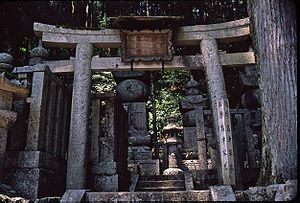Shimazu clan
| Shimazu clan 島津氏 | |
|---|---|
 The Shimazu clan mon | |
| Home province | Satsuma Ōsumi Hyūga |
| Parent house | Seiwa Genji (Minamoto clan) |
| Founder | Shimazu Tadahisa |
| Final ruler | Shimazu Tadashige |
| Current head | Shimazu Nobuhisa |
| Founding year | 12th century |
| Dissolution | still extant |
| Ruled until | 1947, Constitution of Japan renders titles obsolete |

The Shimazu clan (島津氏, Shimazu-shi) were the daimyō of the Satsuma han, which spread over Satsuma, Ōsumi and Hyūga provinces in Japan.
The Shimazu were identified as one of the tozama or outsider daimyō families [1] in contrast with the fudai or insider clans which were hereditary vassals or allies of the Tokugawa clan.
History
The Shimazu were descendants of the Seiwa Genji branch of the Minamoto. The Shimazu would become one of the families of Edo period daimyō to have held their territory continuously since the Kamakura period, and would also become, at their peak, the wealthiest and most powerful tozama family with an income in excess of 700,000 koku.
The founder, Shimazu Tadahisa (d. 1227), was a son of Shogun Minamoto no Yoritomo (1147-1199) with the sister of Hiki Yoshikazu. Tadahisa's wife was a daughter of Koremune Hironobu, descendant of the Hata clan, whose name Tadahisa took at first. He received the domain of Shioda in Shinano Province in 1186 and was then named shugo of Satsuma Province. He sent Honda Sadachika to take possession of the province in his name and accompanied Yoritomo in his expedition to Mutsu in 1189. He went to Satsuma in 1196, subdued Hyūga and Ōsumi provinces, and built a castle in the domain of Shimazu (Hyuga) which name he also adopted.
The 19th head, Yoshihiro (1535–1619), was the daimyō at the time of the Battle of Sekigahara, the establishment of the Tokugawa Shogunate, and the Siege of Osaka.[2] His nephew and successor was Shimazu Tadatsune.[3] He held significant power during the first two decades of the 17th century, and organized the Shimazu invasion of the Ryūkyū Kingdom (modern-day Okinawa Prefecture) in 1609. Tokugawa allowed this because he wished to appease the Shimazu and prevent potential uprisings after their loss at Sekigahara.[4] The trade benefits thus acquired, and the political prestige of being the only daimyō family to control an entire foreign country secured the family's position as one of the most powerful daimyō families in Japan at the time. The Shimazu clan is renowned for the loyalty of its retainers and officers, especially during the Sengoku period. Some retainer families, such as the Ijuin and Shirakawa, were determined to defeat any opposition to help expand the power of the Shimazu clan. The Shimazu are also famous for being the first to use firearms (arquebuses) on the battlefield in Japan, and began domestic production of the weapons as well. Shimazu battle tactics are known to have been very successful in defeating larger enemy armies, particularly during their campaign to conquer Kyūshū in the 1580s. Their tactics included the luring of the opposition into an ambush on both sides by arquebus troops, creating panic and disorder. Central forces would then be deployed to rout the enemy. In this way, the Shimazu were able to defeat much larger clans such as the Itō, Ryūzōji and Ōtomo. Overall, the Shimazu was a very large and powerful clan due to their strong economy both from domestic production through trade, good organization of government and troops, strong loyalty of retainers and isolation from Honshū.
Hisamitsu (1817–1887), regent of Tadayoshi, was the daimyō of Satsuma han at the time of the Boshin War and the Meiji Restoration, in which Satsuma played a major role.[5]
Simplified family tree
Incorporates information from the Japanese Wikipedia article
 I. Shimazu Iehisa, 1st Lord of Satsuma (cr. 1601) (1576-1638; r. 1601-1638)
I. Shimazu Iehisa, 1st Lord of Satsuma (cr. 1601) (1576-1638; r. 1601-1638)
 II. Mitsuhisa, 2nd Lord of Satsuma (1616-1695; r. 1638-1687)
II. Mitsuhisa, 2nd Lord of Satsuma (1616-1695; r. 1638-1687)
- Tsunahisa (1632-1673)
 III. Tsunataka, 3rd Lord of Satsuma (1650-1704; r. 1687-1704)
III. Tsunataka, 3rd Lord of Satsuma (1650-1704; r. 1687-1704)
 IV. Yoshitaka, 4th Lord of Satsuma (1675-1747; r. 1704-1721)
IV. Yoshitaka, 4th Lord of Satsuma (1675-1747; r. 1704-1721)
 V. Tsugutoyo, 5th Lord of Satsuma (1702-1760; r. 1721-1746)
V. Tsugutoyo, 5th Lord of Satsuma (1702-1760; r. 1721-1746)
 VI. Munenobu, 6th Lord of Satsuma (1728-1749; r. 1746-1749)
VI. Munenobu, 6th Lord of Satsuma (1728-1749; r. 1746-1749) VII. Shigetoshi, 7th Lord of Satsuma (1729-1755; r. 1749-1755)
VII. Shigetoshi, 7th Lord of Satsuma (1729-1755; r. 1749-1755)
 VIII. Shigehide, 8th Lord of Satsuma (1745-1833; r. 1755-1787)
VIII. Shigehide, 8th Lord of Satsuma (1745-1833; r. 1755-1787)
 IX. Narinobu, 9th Lord of Satsuma (1774-1841; r. 1787-1809)
IX. Narinobu, 9th Lord of Satsuma (1774-1841; r. 1787-1809)
 X. Narioki, 10th Lord of Satsuma (1791-1858; r. 1809-1851)
X. Narioki, 10th Lord of Satsuma (1791-1858; r. 1809-1851)
 XI. Nariakira, 11th Lord of Satsuma (1809-1858; r. 1851-1858)
XI. Nariakira, 11th Lord of Satsuma (1809-1858; r. 1851-1858)- Hisamitsu, 1st head and Prince of the Shimazu-Tamari line (Shimazu-Tamari line cr. 1871; cr. 1st Prince 1884) (1817-1887)
 Tadayoshi, 12th Lord of Satsuma, 1st Prince Shimazu (1840-1897; r. 1858-1869, Governor of Kagoshima 1869-1871, created 1st Prince 1884)
Tadayoshi, 12th Lord of Satsuma, 1st Prince Shimazu (1840-1897; r. 1858-1869, Governor of Kagoshima 1869-1871, created 1st Prince 1884)
- Tadashige, 13th family head, 2nd Prince Shimazu (1886-1968; 13th family head 1897-1968, 2nd Prince Shimazu 1897-1947)
- Tadahide, 14th family head (1912-1996; 14th family head 1968-1996)
- Nobuhisa, 15th family head (1938-; 15th family head 1996- )
- Tadahiro (1972- )
- Nobuhisa, 15th family head (1938-; 15th family head 1996- )
- Tadahide, 14th family head (1912-1996; 14th family head 1968-1996)
- Tadashige, 13th family head, 2nd Prince Shimazu (1886-1968; 13th family head 1897-1968, 2nd Prince Shimazu 1897-1947)
- Tadasumi, 2nd head and Prince of the Shimazu-Tamari line (1855-1915; 2nd head and Prince 1887-1915)
- Tadatsugu, 3rd head and Prince of the Shimazu-Tamari line (1903-1990; 3rd head 1915-1990; 3rd Prince 1915-1947)
- Tadahiro, 4th head of the Shimazu-Tamari line (1933- ; 4th head 1990 - )
- Tadami (1961 - )
- Tadayoshi (1993 - )
- Tadami (1961 - )
- Tadahiro, 4th head of the Shimazu-Tamari line (1933- ; 4th head 1990 - )
- Tadatsugu, 3rd head and Prince of the Shimazu-Tamari line (1903-1990; 3rd head 1915-1990; 3rd Prince 1915-1947)
- Tsunahisa (1632-1673)
Order of Succession
- Shimazu Tadahisa
- Shimazu Tadatoki[7]
- Shimazu Hisatsune[7]
- Shimazu Tadamune
- Shimazu Sadahisa[7]
- Shimazu Morohisa
- Shimazu Ujihisa
- Shimazu Yuihisa
- Shimazu Motohisa
- Shimazu Hisatoyo
- Shimazu Tadakuni
- Shimazu Tachihisa
- Shimazu Tadamasa
- Shimazu Tadaosa
- Shimazu Tadataka
- Shimazu Katsuhisa
- Shimazu Takahisa[8]
- Shimazu Yoshihisa[9]
- Shimazu Yoshihiro[2]
- Shimazu Tadatsune[3]
- Shimazu Mitsuhisa
- Shimazu Tsunataka
- Shimazu Yoshitaka
- Shimazu Tsugutoyo
- Shimazu Munenobu
- Shimazu Shigetoshi
- Shimazu Shigehide[10]
- Shimazu Narinobu
- Shimazu Narioki
- Shimazu Nariakira[11]
- Shimazu Tadayoshi (with his father, Shimazu Hisamitsu,[5] as regent)
- Shimazu Tadashige
- Shimazu Toyohisa
- Shimazu Yoshihiro A
Other Members
- Shimazu Sanehisa
- Shimazu Kiriyama (Exiled, self-imposed)
- Shimazu Shigehide[12]
Important Retainers
The Shimazu shichi-tō comprised the seven most significant vassal families—the Niiro, Hokugō, Ijuin,[13] Machida, Kawakami, Ata and Kajiki.[14]
- Ijuin Tada'aki
- Ijuin Tada'ao
- Ijuin Tadamune
- Ijuin Tadazane
- Niiro Tadamoto
- Yamada Arinobu
- Yamada Arinaga
- Kabayama Hisataka[15]
- Saigō Takamori[16]
- Shō Nei, King of Ryūkyū[17]
- Shō Tai, King of Ryūkyū[17]
See also
Notes
- ^ Appert, Georges et al. (1888). Ancien Japon, pp. 77., p. 77, at Google Books
- ^ a b Nussbaum, Louis Frédéric et al. (2005). "Shimazu Yoshihiro" in Japan encyclopedia, p. 860., p. 860, at Google Books; n.b., Louis-Frédéric is pseudonym of Louis-Frédéric Nussbaum, see Deutsche Nationalbibliothek Authority File.
- ^ a b Nussbaum, "Shimazu Tadatsune" at p. 860., p. 860, at Google Books
- ^ Kerr, George H. (2000). Okinawa: the History of an Island People, p. 158., p. 158, at Google Books
- ^ a b Nussbaum, "Shimazu Hisamitsu" at p. 861., p. 861, at Google Books
- ^ Shimazu genealogy
- ^ a b c Kerr, p. 58., p. 58, at Google Books
- ^ Nussbaum, "Shimazu Takahisa" at p. 860., p. 860, at Google Books
- ^ Kerr, p. 153., p. 153, at Google Books
- ^ Nussbaum, "Shimazu Shigehide" at p. 246., p. 246, at Google Books
- ^ Nussbaum, "Shimazu Nariakira" at p. 861., p. 861, at Google Books
- ^ Nussbaum, "Shimazu Shigehide" at p. 861., p. 861, at Google Books
- ^ Nussbaum, "Ijuin" at p. 375., p. 375, at Google Books
- ^ Papinot, Jacques. (2003). Nobiliare du Japon, p. 55.
- ^ Chamberlain, Basil Hall. "The Luchu Islands and their Inhabitants," The Geographical Journal, No. 4, Vol. 5 (April 1895), p. 309.
- ^ Nussbaum, "Saigō Takamori" at pp. 805-806., p. 805, at Google Books
- ^ a b Nussbaum, "Shō" at pp. 805-806., p. 805, at Google Books
References
- Appert, Georges and H. Kinoshita. (1888). Ancien Japon. Tokyo: Imprimerie Kokubunsha. OCLC 4429674
- Nussbaum, Louis Frédéric and Käthe Roth. (2005). Japan Encyclopedia. Cambridge: Harvard University Press. ISBN 978-0-674-01753-5; OCLC 48943301
- Kerr, George H. and Mitsugu Sakihara. (2000). Okinawa, the History of an Island People. Tokyo: Tuttle Publishing. ISBN 9780804820875; OCLC 247416761
- Papinot, Jacques Edmund Joseph. (1906) Dictionnaire d'histoire et de géographie du japon. Tokyo: Librarie Sansaisha. OCLC 465662682; Nobiliaire du japon (abridged version of 1906 text).
- Sansom, George. (1958). A History of Japan: 1615-1867. Stanford University Press. OCLC 607164037
